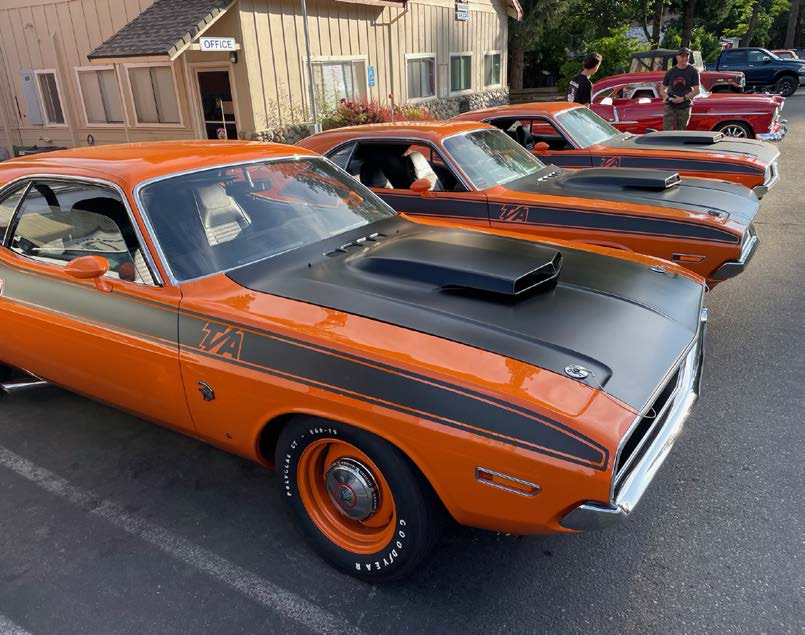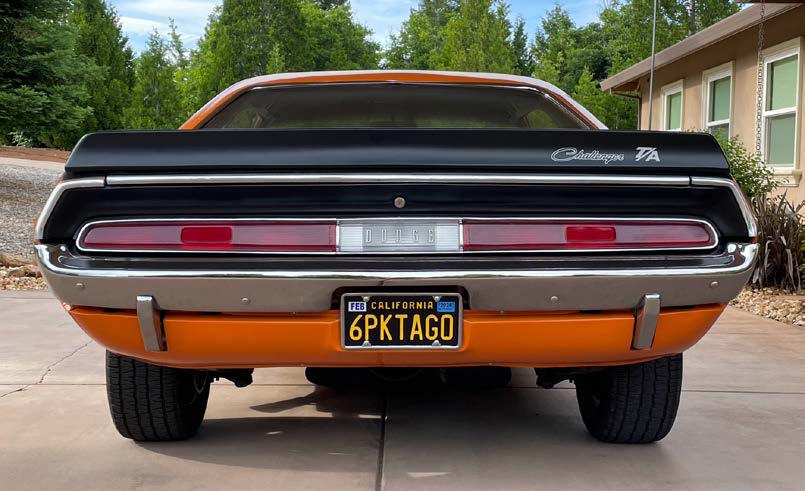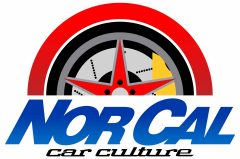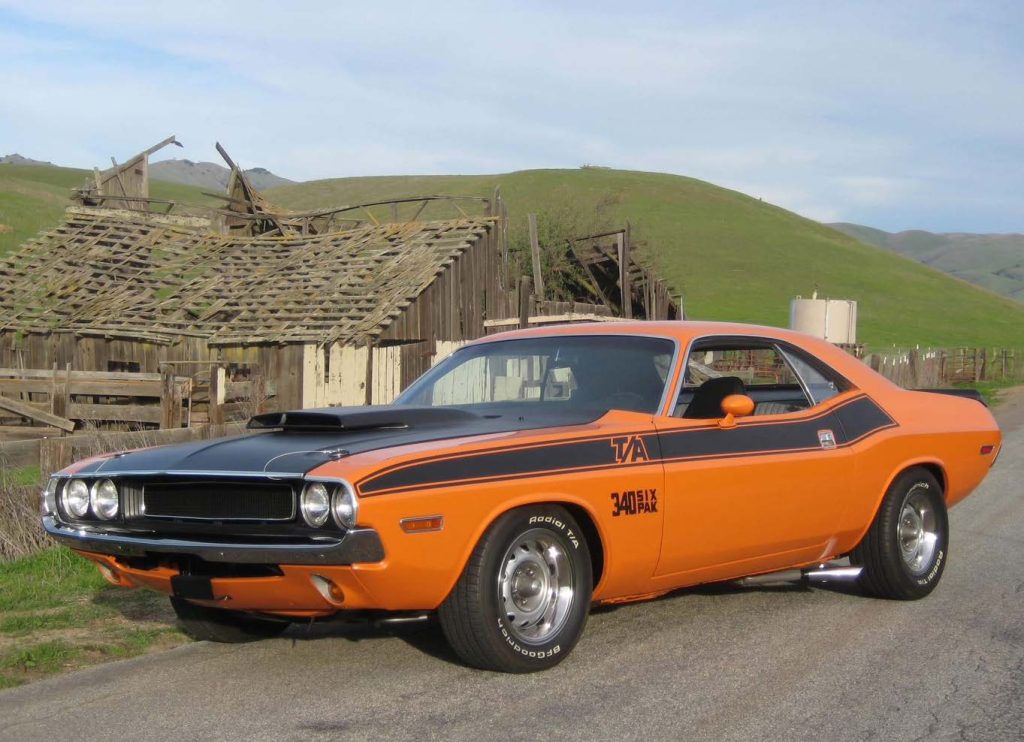My story starts, like many Mopar stories, with “who
you know” and “how did you find that Mopar”. Nearly
all of the classic and Mopar muscle cars I have owned
over the years and/or still have today are because I’ve
had great friends looking out for me, since they knew I
have always had a passion for ANYTHING Mopar! As
some members of Mopar Alley may know, after 37.5
years, I retired from a company in San Jose / Santa Clara by the name of FMC, which later became United
Defense, and eventually was acquired by BAE Systems.
I used to put on an annual car show, called the SAE
MotorFest, at our facility on Coleman Avenue, which
several Mopar Alley members attended over its 17
years of existence. Internal to the company, we also
hosted a Diversity Fair, where several of us that had
and liked anything cars, trucks and motorcycles
displayed our vehicles once a year for other employees
to see.
One of the people I worked with who was also into
cars and enjoyed displaying his vehicles at our Diversity
Fair and SAE MotorFest events was a friend of mine by the name of Jack Costella. Jack was the foreman of our
model shop at Plant 7, our company’s experimental
shop where everything from scale models to full-scale
world-class prototype tracked vehicle were made for
both the Army and Marine Corps.
When Jack wasn’t at work, he spent evenings and
weekends building and working on hot rods, as well as other things that moved and intrigued him. In 1969,
Jack set his first world speed record, of all things, with
a Bonanza mini bike, not once, but twice in the late
1960’s when he worked for Bonanza in his early years
– both achieved speeds over 75 mph. Although he
wasn’t the driver of the mini bike, he was one of the
key builders. By the mid-1980’s, Jack got the urge to
race again after going to Bonneville and became
fascinated with streamliners. It was then, that Jack set
out to break another world speed record, but this time
developing from scratch a streamliner of his own
design. You see, he was one of those guys that could
build just about anything you asked him to and/or he
put his mind to, whether at work or at home. Jack was
one of the smartest non-degreed designers I’d ever
met and I always looked forward to seeing his next
creation and what he was going to display at our
events. By 1992, Jack set his first of many streamliner
world speed records at Bonneville – at a speed of over
239 mph. That got my attention, as it would anyone,
and Jack and I would often discuss design ideas and his
next speed record goal and/or project.
In one of our many conversations, Jack mentioned to
me in 1993 that he had a friend who also raced
Bonneville streamliners and was sponsored by Mopar
– his name was Dave Dozier. Jack told me that Dave
had several Challengers he had been getting rid of, and
there was one last one that he hadn’t sold as there
weren’t many of them made.
It happened to be the 1970 Dodge
Challenger T/A I now own today.
I immediately called Dave and went over to his home
in Saratoga, CA. When I got to Dave’s house and he
gave me the grand tour of his garages, I quickly
realized that Dave not only raced, but he collected any
unique Mopars, including everything from a Chrysler
Airflow to a 1966 Hemi Charger that he was the
original owner of. He even loaned cars out to movie
companies to use in their productions.
 When we got around to Dave showing me the
When we got around to Dave showing me the
Challenger T/A, it was obvious that it needed a lot of
work. The car was going to not only need paint, as the
color was wrong and it was primered in some areas,
but the interior needed to be refreshed and Dave
mentioned the wrong heads were installed on the
block. There was absolutely nothing from the exterior
of the car other than the hood that gave you the
impression it was recognizable as a T/A. Luckily, the
VIN and fender tag indicated it was a Challenger T/A,
and Dave even had the build sheet for the car. After
some discussion on price and him agreeing to re-install
the correct heads on the engine, we struck a deal a few
months later, and I loaded the car on my car trailer and
brought it home.
For the first 15 or so years, the car was
always parked in my garage and I would
take it out for a short drive once or twice
a month.
It wasn’t until about 2008 that I decided to start a
restoration on the car. A good friend of mine by the
name of Dave Ingles was an excellent paint and body
man by trade, and he agreed to work on my car on the
side in his spare time. We decided it would be best to
strip the car and take it down to bare metal.
I remember shortly after that having a dismantling
party in my garage where four of my friends, including
Dave, came over, we collectively disassembled the car
and bagged-and-tagged everything. After Dave got the
car and started stripping the paint down to bare metal,
we quickly discovered the car had, at one time, been in
an accident and the right rear quarter panel was filled
with Bondo and beyond repair. Dave, being the skilled
craftsman he was, cut out the old quarter panel, which
turned out not to be original, and rewelded a new
quarter panel back in, consistent with how the factory
would have done it and how the previous quarter
panel should have been welded in place.
When Dave finished the painting of the body about four months later, I picked the car up and put it back in
my garage to be reassembled. After having it sit for
over a year and it not getting the restoration attention
it deserved due to our family keeping busy, as well as
work obligations and travel, I decided to give it back to
Dave for reassembly and to get it running again. Dave
completed everything except the interior, exterior trim,
and lights. It was then up to me to complete the rest
of the reassembly, which was completed in 2010.
Of the 2399 Challenger T/A’s produced for
the US market, only 989 were equipped
with pistol-grip four-speeds, like my car.
During my restoration research, in addition to knowing
the Hemi Orange paint was the wrong color on “part
of the car” when I bought it, I also discerned the
interior in the car was incorrect. Rather than the car
being equipped with the black vinyl interior it had, it
should have been equipped with salt & pepper cloth
inserts as well. Needless to say, I was thrilled when I
found out how rare this option was on a Challenger, let
alone a Challenger T/A. According to Barry
Washington, the Challenger T/A authority, my car is
only one of five known to exist with a 4-speed in the
Go Mango orange color and having the salt & pepper
interior. Oddly enough, mine is one of two consecutive
Challenger T/A’s built with these exact same options.
 In the restoration of the car, there are two things that I
In the restoration of the car, there are two things that I
have installed that are not original options to the car,
but were an option for that year. I have added the
passenger side, body-colored, rear view mirror (to
match the driver’s side mirror) and I installed a rally
dash with the 8K tachometer.
When I bought the car, Dave Dozier had also installed
a 4:10:1 rear end in the car, which I kept in it for many
years. It was fun as I could lay rubber in all four gears,
but it wasn’t practical for the freeway or long drives. A
few years ago, I finally installed the 3.55:1 rear end
gear that was originally optioned on the car and I have
since enjoyed driving it much more these days. In the
past few years, I have become friends with two other 1970 Go Mango
Challenger T/A owners – one has 4-speed car without
the salt & pepper interior, and the other is the owner of
the tribute Challenger T/A that appeared in Season 17 of
Graveyard Carz and is equipped with the supercharged
800+ HP HELLcrate Redeye 6.2L engine. You might see
us from time to time, going to car shows together and
really putting smiles on people’s faces.
My Dodge Challenger T/A wears a black and yellow
personalized license plate of
6PKTAGO, which took me
years to obtain. It is a Challenger “T/A”
(for Trans Am) and has a 340 engine with a 6-bbl (three 2-bbl)
carburetor set-up, which Dodge called a“6-Pak”
. Its color is “Go Mango” or “Go-Man-Go” (Chrysler always
played on words). Growing up in the liquor business
and working for my Dad in the liquor stores, I always
heard people come in and ask for a “Six pack (of beer)
to (ta) go” – “6PK” “T/A” “Go” – hence the 6PKTAGO license plate.
Dave Ingles has remained one of my best friends over
the years and he has painted another one of my
Mopars for me since. Although he is now retired, Dave
finally has time to work on restoring several of his
classics and muscle cars. You’ll likely see them at car
shows in the near future. If you’re wondering about
Jack Costella and Dave Dozier, between them, they set
over 100 world records on the salt flats and both
became members of the 300-mph club at Bonneville
before their passings. It was an honor to know both of
them and it is only because of these great Bonneville
salt flat racers, their creative geniuses, and me getting
to know them that I own the car I still have today after
32 years. It has become a car that is the envy of all of
our children and grandchildren, one which they all
someday want to own. It will stay in our family for
years to come, and will always have a special
place in my heart and my shop until it is
passed down through our family members.

